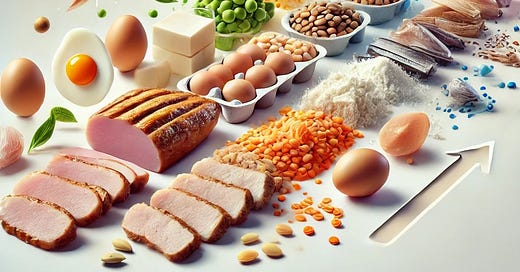I’m Brandon Wilson. I am constantly working toward improving my mind, body, and spirit using various ancient techniques and cutting-edge biohacking tools and devices. I want to be healthy, but not at the expense of being happy. This simple idea is what it means to be wellthy.
First time reading? Let’s get you in the club.
🎧 Audio Teaser
Here is a taste of the audio voiceover that Be Wellthy Club members can listen to in every newsletter.
You are likely familiar with the three categories of macronutrients: carbohydrates, fats, and protein. Carbohydrates break down into glucose, the body's primary energy source. Fat is also used as an energy source and for energy storage, cell membranes, insulating nerves, and creating hormones. I hear people say, “Make sure to eat enough protein.” But how is protein used in the body, and how important is it?
The word protein comes from the Greek word Pröteîos, which means "of the first quality," and the Greek word prôtos, meaning first, foremost. Proteins play many vital roles in the body:
They give structure to tissues, organs, and muscles.
They form antibodies to fight off infection.
They make hemoglobin to carry oxygen around the body in the blood.
They create hormones.
Enzymes are a specialized class of proteins.
What happens when you don't get enough high-quality protein? The structure of your body starts to break down. You have a loss of muscle mass and muscle weakness. You have increased susceptibility to infections, delayed recovery, and poor wound healing. You have brittle or thinning hair, weak nails, and skin issues. You have hormonal imbalances. You might get anemia. Insufficient protein intake will lead to many physical problems.
High-quality protein is critical because the body breaks it down into basic structures used everywhere. The basic building block of protein is called an amino acid. There are twenty standard amino acids found in the proteins of living organisms. Nine of these amino acids are called essential amino acids because the body cannot manufacture them, and you must get them through your diet. Here is a list of the nine essential amino acids and their functions.
The Nine Essential Amino Acids
Histidine - Histamine production, immune response, tissue repair
Isoleucine - Muscle metabolism, energy production, immune function
Leucine - Muscle protein synthesis, energy regulation
Lysine - Collagen formation, calcium absorption, immune function
Methionine - Protein synthesis, antioxidant defense, detoxification
Phenylalanine - Precursor for neurotransmitters, protein synthesis
Threonine - Protein synthesis, collagen production, immune function
Tryptophan - Precursor for serotonin and melatonin. Turkey is high in tryptophan, which is why you may feel sleepy after that big Thanksgiving meal. Jerry Seinfeld used this trick in a memorable episode.
Valine - Muscle metabolism, tissue repair, energy balance
The nine essential amino acids, along with the eleven non-essential amino acids the body can make, organize into various structures. Amino acids are like letters; when you combine two or more, you get a "word" called a peptide. A peptide is a chain of anywhere from two to fifty amino acids.
Peptides play various roles in the body:
Signaling molecules that act as hormones like insulin.
Neurotransmitters like endorphins.
Antimicrobial agents functioning within the immune system
Structural components of cells and tissues
Enzyme inhibitors
Now that we understand the importance of protein and essential amino acids let’s discuss the best sources.
Animal and Plant-Based Protein Sources
Most animal sources are complete proteins because they contain all nine essential amino acids in the proper proportions.
Animal protein sources
Grass-fed, grass-finished beef and lamb
Pastured duck, goose, chicken, and turkey (limit due to high omega-6 fat content)
Organic, pastured eggs
Wild-caught seafood - Choose fish that are lowest in mercury: anchovies, sardines, haddock, sockeye salmon, summer flounder, wild tilapia, and wild trout.
Grass-fed collagen protein - Collagen supports the gut, heals cartilage, improves the skin, and supports bone health.
Colostrum from grass-fed cows - Colostrum supports the immune system and the gut.
Whey protein concentrate - Whey protein supports glutathione production, and concentrate is less processed and has more nutrients and growth factors than whey protein isolate. Whey protein isolate may be a better option for people sensitive to lactose.
Dairy products (if tolerated) - Grass-fed, organic, raw, full-fat milk, cream, yogurt, or cottage cheese
There are some good plant-based sources of amino acids, though many are incomplete proteins because they lack one or more essential amino acids.
Plant-based protein sources
Cruciferous vegetables like broccoli, cauliflower, Brussels sprouts, and cabbage
Sweet potatoes, carrots, and beets
Leafy greens like spinach, swiss chard, and collard greens
Citrus fruits, berries, apples, and bananas
Avocado
Coconut
Chia and hemp seeds - complete protein source
Buckwheat - complete protein source
Spirulina - a blue-green algae that is a complete protein source.
Amaranth - ancient grain that is a complete protein source.
Nutritional yeast - complete protein source
Quinoa -complete protein source, although Dr. Gundry says quinoa doesn’t belong in a healthy diet.
Beans - Legumes are protein-rich, but they also contain lectins, which can cause various health problems.
Soy products - While high in protein, soy products may be suspect due to high omega-6 content, antinutrients, and phytoestrogens. Study results have been mixed, but there are some indications that soy may cause hormonal disruption.1 Fermented soy products, such as tempeh, miso, and natto, are marginally better.
Consuming the Right Amount of Protein
The amount of protein you should eat daily varies depending on gender, age, muscle-mass-to-fat ratio, and lifestyle. The recommended dietary allowance (RDA) for protein is 0.36 g per pound of body weight (0.8 g per kilogram of body weight). For most adults, about 20% of daily calories should be from protein. If you don’t want to do the math, use this online calculator. It is better to spread protein intake across meals instead of consuming large quantities in a single meal. A general guideline would be 20-40 grams of protein per meal.
While it is crucial to consume sufficient protein, too much protein can be problematic. Anyone consuming large quantities of protein should consider the possibility of extra nitrogenous waste. When amino acids are not needed for protein synthesis or other functions, the liver initiates a deamination process that removes an amino group. This process produces ammonia, a toxic compound, which converts into urea. Certain high-protein foods also contain purines, which may increase uric acid. Excess uric acid may form crystals in joints and cause a painful condition called gout. Excess byproducts from consuming too much protein can cause kidney problems, leading to various conditions.
Many people consume powders and other supplements to increase protein and amino acid intake. In an upcoming newsletter, I will share a fantastic source of amino acids I’ve been taking.
The Daily Habit is where I share my habits related to the fundamentals: sleep, diet, physical activity, mindfulness, and stress management.
Cronometer is a free app that allows you to track your diet, exercise, and health data. You can use the phone app to scan bar codes and easily track nutrient intake. It shows you all nine essential amino acids so you can determine whether you are getting enough based on your goals.
I start every morning with a glass of filtered, structured water with BEAM minerals. This is the best mineral supplement on the market, in my opinion. They even have formulations for dogs and cats and a cheaper pill form of the liquid supplement. I provided more details in a previous newsletter. Go to the BEAM minerals website and use code BRANDON51920 to save 20%.
Congratulations to the July raffle winners 🎉 🎁
Free raffle entry winner: Barbara S.
Be Wellthy Club raffle winners: Renata B. and Joe B.
Free raffle entrants: None
Be Wellthy Club entrants: Amy S., Scott L., Ariel E., Scott S., Renata B.
Free subscribers can still enter to win one monthly raffle prize. Club members get an automatic entry each month to win one of two monthly raffle prizes. All you have to do is email bewellthy@substack.com the correct answer to each week’s brain training, and you will be entered into a monthly raffle to win cool biohacking prizes. You must be a subscriber to win! I do respond to every email.
This week:
There is a certain logic shared by the four circles below. Determine the missing number in the last circle.
For proper hydration, you want to start with filtered water and then remineralize it. The body performs one more step, called structuring water, which you can do in advance. One year ago, I wrote about one method for structuring water and why it is beneficial.
Beyond hydration: Using water's hidden secret to feel amazing
I’m Brandon Wilson. I am constantly working toward improving my mind, body, and spirit using various ancient techniques and cutting-edge biohacking tools and devices. I want to be healthy, but not at the expense of being happy. This simple idea is what it means to
Keep your loved ones informed with the most up-to-date information about wellness by sharing this newsletter.
https://www.scientificamerican.com/article/soybean-fertility-hormone-isoflavones-genistein/
Keep reading with a 7-day free trial
Subscribe to Be Wellthy to keep reading this post and get 7 days of free access to the full post archives.











